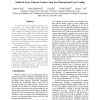114 search results - page 4 / 23 » Using likely program invariants to detect hardware errors |
MICRO
2007
IEEE
14 years 1 months ago
2007
IEEE
In deep sub-micron ICs, growing amounts of ondie memory and scaling effects make embedded memories increasingly vulnerable to reliability and yield problems. As scaling progresses...
ATVA
2004
Springer
14 years 26 days ago
2004
Springer
Data races do not cover all kinds of concurrency errors. This paper presents a data-
ow-based technique to
nd stale-value errors, which are not found by low-level and high-level d...
TAP
2009
Springer
14 years 2 months ago
2009
Springer
The method contract and loop invariant rules (contract rules) are an important software verification technique for handling method invocations and loops. However, if a verificati...
DSN
2008
IEEE
14 years 1 months ago
2008
IEEE
This paper introduces SymPLFIED, a program-level framework which allows specification of arbitrary error detectors and the verification of their efficacy against hardware errors. ...
ENDM
2010
13 years 7 months ago
2010
Verifying that a piece of software has no bugs means proving that it has certain desired properties, such as an array index not taking values outside certain Abstract interpretati...

